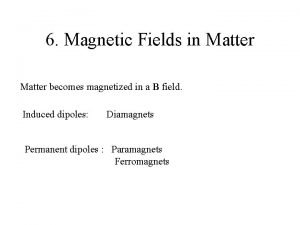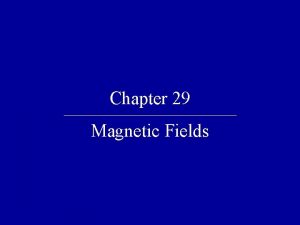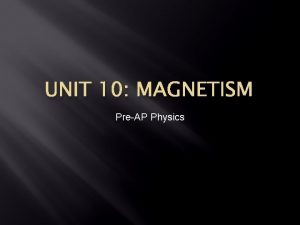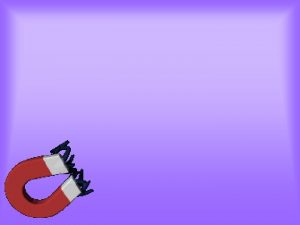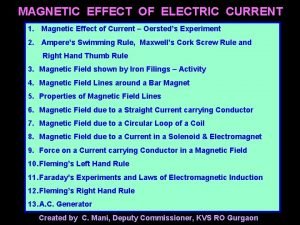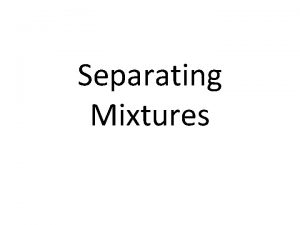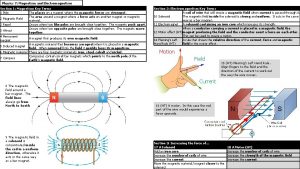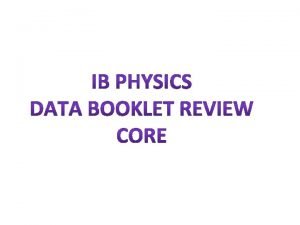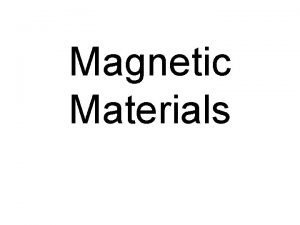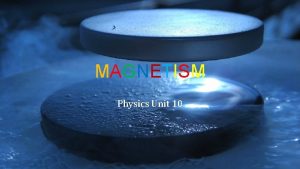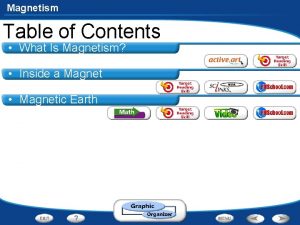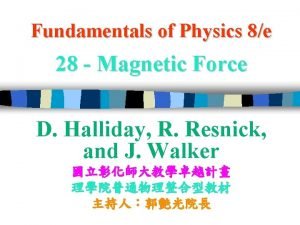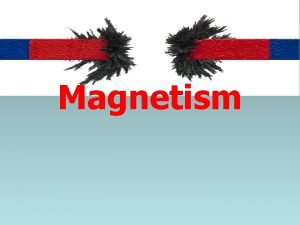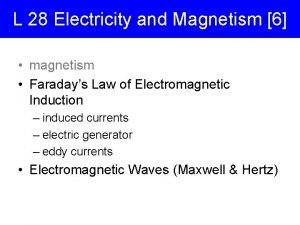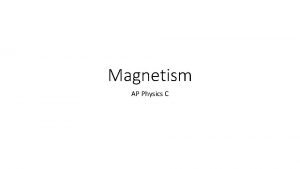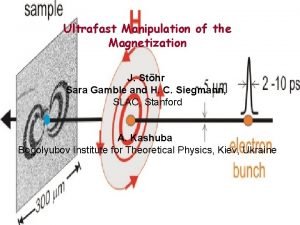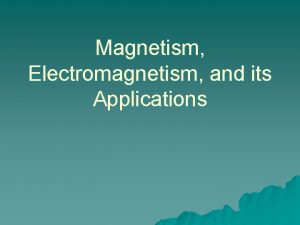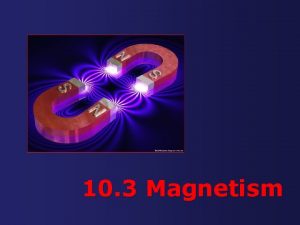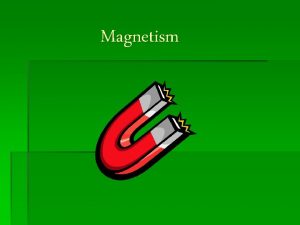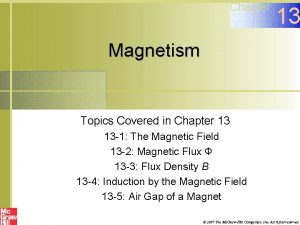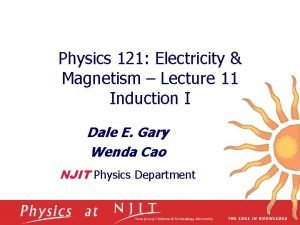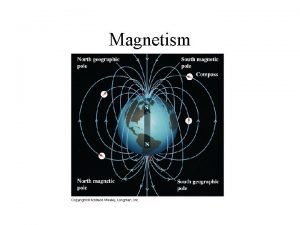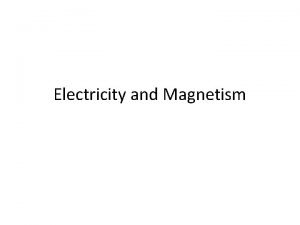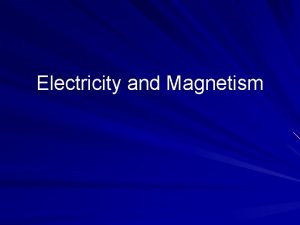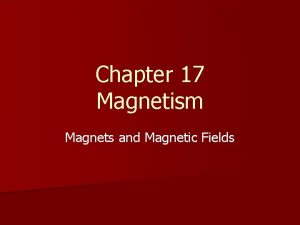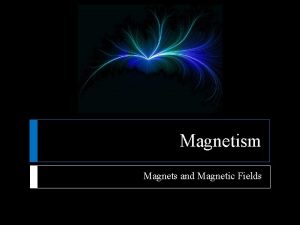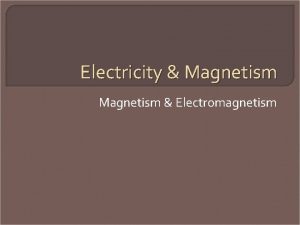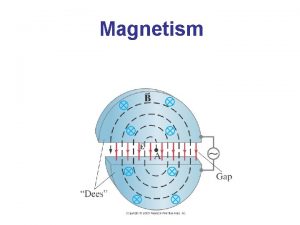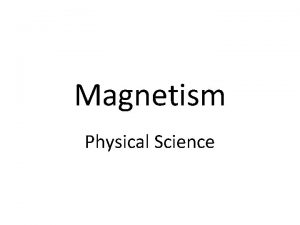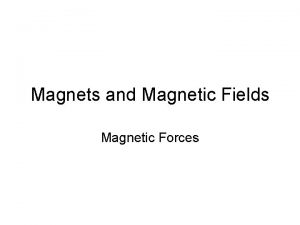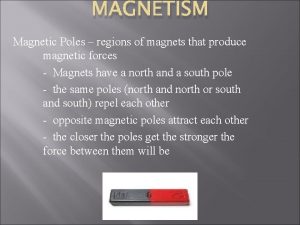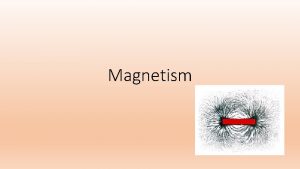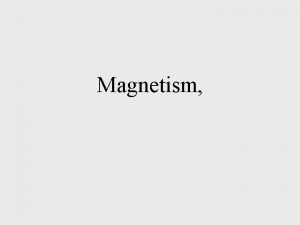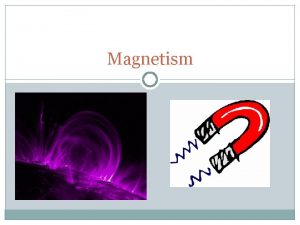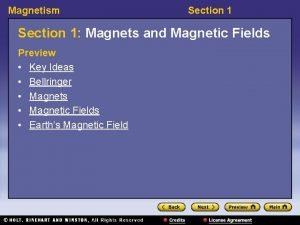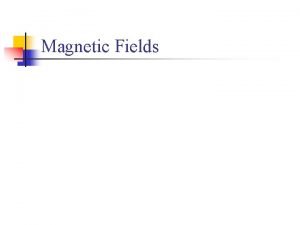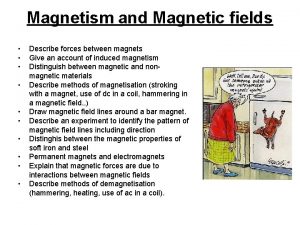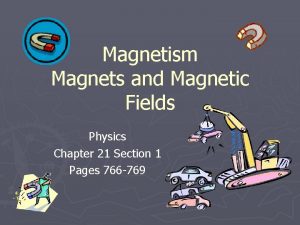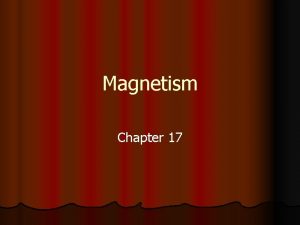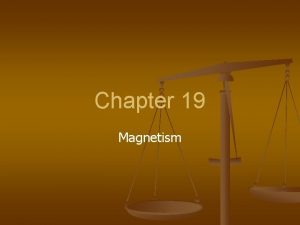Magnetism 12 1 Magnets Magnets produce magnetic fields








































- Slides: 40

Magnetism

12. 1 Magnets

Magnets – produce magnetic fields and attract ferromagnetic elements Poles – ends of magnets where the magnetic field is strongest North Pole – attracted to the North Geographic Pole of the earth This is actually a South magnetic pole 12. 1 Magnets

Like poles repel Unlike poles attract If a magnet is broken, new pole appear Magnetic Field (B)the direction of the force on a North magnetic monopole Away from a North pole, toward a South Pole 12. 1 Magnets

The field lines are 3 dimensional 12. 1 Magnets

12. 2 Earth’s Magnetic Field

Compass – a tiny magnet suspended so that the North pole points toward the North Geographic pole of the earth The Geographic North pole and the magnetic pole are not in exactly the same place Probably due to current in the liquid core of the earth This field protects us from solar radiation 12. 2 The Earth’s Magnetic Field

12. 3 Magnetic Fields

Magnetic fields apply forces to charged particles Only if they are moving The Force is q – charge in coulombs v – velocity of charge q– angle between v and B 12. 3 Magnetic Fields

The equation is used to define the magnetic field B – measured in tesla (T) or a weber per meter squared (Wb/m 2) Regular magnets produce fields up to 2. 5 T Superconducting magnets – fields up to 30 T Earth’s Magnetic field – 0. 00005 T 12. 3 Magnetic Fields

The direction of the force is perpendicular to the plane of v. B We use the right hand rule to determine the directional relationship between these three values 1. Point fingers in direction of current or v 2. Palm points toward magnetic field (B) 3. Thumb points in the direction of the force 12. 3 Magnetic Fields

There are different versions of the right hand rule – they all give you the correct directions The rule is for a positive charge, a negative charge will have a force in the opposite direction 12. 3 Magnetic Fields

12. 4 Mag. Force on a Current Carrying Conductor

Current carrying wires Charges moving through a wire Current is charge per unit time Velocity is define as So l – length of wire in the magnetic field 12. 4 Mag. Force on a Current Carrying Conductor

q– the angle between the magnetic field and the conductor (l) Used in speakers Motors 12. 4 Mag. Force on a Current Carrying Conductor

12. 5 Torque on a Current Loop

If a rectangular loop is place in a magnetic field, and a current is run through the loop Using the right hand rule -force is into the board at the top -out of the board at the bottom Causes toque (rotating) 12. 5 Torque on a Current Loop

Torque is Combining with our force equation Since we have two torques going in the same direction The area would be = 2 lr 12. 5 Torque on a Current Loop

Often multiple loops of wire are used N – is the number of turns of wire loops An increase in turns results in an increase in torque 12. 5 Torque on a Current Loop

12. 6 Motion of a Charge Particle in B

If a charged particle is injected perpendicular to a magnetic field The particle will move in in a circular path The force is centripetal We can solve for radius 12. 6 Motion of a Charge Particle in B

A mass spectrometer using this idea to measure the mass of charged particles First the particle is accelerated through a potential difference and potential energy is converted to kinetic The radius is detect by the collison of the particle with a screen 12. 6 Motion of a Charge Particle in B

12. 7 Magnetic Field of a Long Straight Wire

Hans Christian Oersted – observed a compass deflected near a wire carrying electric current A magnetic field is formed around the wire 12. 7 Magnetic Field of a Long Straight Wire

The direction of the field can be determined by the right hand rule Thumb points in the direction of the current Fingers curl in the direction of the magnetic field The magnetic field can be calculated by 12. 7 Magnetic Field of a Long Straight Wire

m 0 is called the permeability of free space This is Ampere’s Circuital Law 12. 7 Magnetic Field of a Long Straight Wire

12. 8 Mag Force Between 2 Parallel Conductors

If the force on a current carrying wire is And the field is Combining r is replaced with the distance between the wires - d 12. 8 Mag Force Between 2 Parallel Conductors

12. 9 Magnetic Field of a Current Loop

Using the right hand rule, if a current is placed in a wire loop Repeated coils will produce an electromagnet 12. 9 Magnetic Field of a Current Loop

12. 10 Magnetic Domains

Domains – large groups of atoms with electron spin aligned Magnetism is a product of a charged electron spinning When domains line up, a magnet is formed Permanent magnets – the domains stay aligned 12. 10 Magnetic Domains

12. 11 Induced EMF and Magnetic Flux

Michael Faraday – when a coil of wire first has a current placed in it, a current will momentarily occur in a second coil nearby The same thing happens if a magnet is moved through a coil of wire 12. 11 Induced EMF and Magnetic Flux

An electric current is produced by a changing magnetic field This is an induced emf Actually caused by a change in magnetic flux The magnetic flux is proportional to the total number of magnetic field lines passing through a loop Unit Tm 2 or Wb 12. 11 Induced EMF and Magnetic Flux

12. 12 Faraday’s Law of Induction

The emf produced in a circuit by a change in flux can be calculated as E – induced emf (volts) N – number of turns of wire DF-change in magnetic flux (Tm 2) Dt – time (seconds) 12. 12 Faraday’s Law of Induction

Lenz’s Law – The direct of the induced emf always produces a current whose magnetic field opposes the change in flux. 12. 12 Faraday’s Law of Induction

12. 13 Generators

Generators produce a potential difference by moving loops of wire in a magnetic field 12. 13 Generators
 Scrap heap magnet diagram
Scrap heap magnet diagram Red fields
Red fields Conceptual physics magnetism
Conceptual physics magnetism Bbc bitesize electric bell
Bbc bitesize electric bell Electric currents and magnetic fields
Electric currents and magnetic fields Learning: module 26: magnetic forces and fields
Learning: module 26: magnetic forces and fields Electric currents and magnetic fields
Electric currents and magnetic fields Magnetic fields in matter
Magnetic fields in matter Magnetic force quiz
Magnetic force quiz Magnetic moment and magnetic field relation
Magnetic moment and magnetic field relation Magnetic force particle
Magnetic force particle Types of ferrites
Types of ferrites Magnetic flux density formula
Magnetic flux density formula Preap magnetism 1
Preap magnetism 1 It is an invisible force
It is an invisible force Ib physics electricity and magnetism
Ib physics electricity and magnetism Snow rule in magnetism
Snow rule in magnetism Magnetism.eu
Magnetism.eu Example of magnetism in separating mixtures
Example of magnetism in separating mixtures Hysteresis loop for magnetic material
Hysteresis loop for magnetic material Magnetism and electromagnetism
Magnetism and electromagnetism Electricity and magnetism
Electricity and magnetism Magnetic flux units
Magnetic flux units Magnetism
Magnetism Electricity and magnetism lecture notes
Electricity and magnetism lecture notes Table
Table Types of magnetism
Types of magnetism Why magnetism is important
Why magnetism is important Magnetism
Magnetism Sph3u electricity and magnetism
Sph3u electricity and magnetism Magnetism
Magnetism Magnetism jeopardy
Magnetism jeopardy Ultrafast magnetism
Ultrafast magnetism Applications of magnetism
Applications of magnetism Influens magnetism
Influens magnetism Magnetism love
Magnetism love Characteristics of magnetism
Characteristics of magnetism Magnetism
Magnetism Electricity and magnetism
Electricity and magnetism Relationship between electricity and magnetism
Relationship between electricity and magnetism Influens magnetism
Influens magnetism







